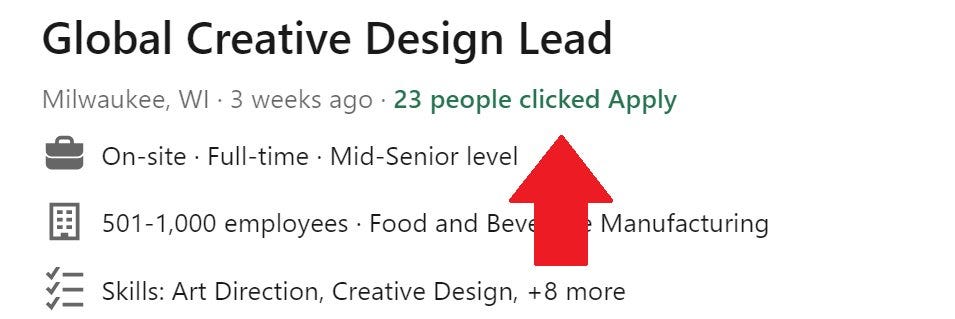How to Beat LinkedIn's High Applicant Numbers and Get Hired
Learn why job listing applicant numbers are misleading and get insider tips to boost your chances of landing an interview, even with seemingly high competition.
You're excitedly scrolling through job listings when you finally spot it — your dream role at an amazing company. Your heart races as you eagerly read through the job description, mentally checking off how you're a perfect match for each requirement. But just as you're about to hit 'Apply,' you see it: '1,358 applicants.
Your stomach sinks. With that many people in the running, what are the odds they'll even look at your resume? Suddenly, applying feels like playing the lottery. Why bother when your chances seem so slim?
If this scenario feels painfully familiar, you're not alone. An intimidatingly large applicant pool can make even the most confident job seeker question their chances.
But here's the thing: that number is incredibly misleading!
LinkedIn's Misleading "Applicant" Numbers
For years, LinkedIn prominently displayed the number of "applicants" on each job posting. Seeing a number in the hundreds or thousands was enough to make any job seeker feel like the odds were stacked against them.
However, that count was incredibly misleading. LinkedIn actually showed the number of clicks on the posting, not the number of completed applications.
LinkedIn's Attempts to Clarify
To their credit, LinkedIn eventually realized how disheartening those high numbers could be. In an attempt to soften the blow, they started showing "Over 100 applicants" for any posting that had received 100+ clicks. While this may have felt a little less intimidating than seeing '1,358 applicants,' it still wasn't an accurate picture of the competition.
More recently, LinkedIn has experimented with changing the wording to show how many people "clicked" on the posting rather than implying they were all applicants. But unless you were paying close attention, you might not have noticed this subtle shift.
Clicks ≠ Qualified Applicants
The key thing to understand is that a click is not the same as a qualified applicant. In my decade of experience as a recruiter, I can confidently say that an extremely small percentage of those who click "Apply" make it to the interview stage.
Why is there such a disparity? For starters, a large chunk of "applicants" haven't read the job description closely and don't meet the core requirements. Plenty of others need visa sponsorship to work in the country, which many companies can't provide. Those candidates are typically screened out immediately.
So while the applicant number may look alarmingly large at first glance, the reality is that your true competition is a small fraction of that. Dozens or even hundreds of those 'applicants' are ruled out right off the bat. That should give you a huge confidence boost! You're not really going toe-to-toe with 1,358 other people. Not even close.
Many "Applicants" Don't Meet Basic Requirements
Let's dig a little deeper into why the applicant pool shrinks so dramatically. As a recruiter, I've seen countless candidates get instantly rejected for a few common reasons:
1. Lack of Required Skills or Experience
One of the quickest ways to get screened out is by applying for roles you're not qualified for. Job descriptions typically list the must-have skills, experiences, or educational background. If you don't check those boxes, it's an automatic "no".
I get it - sometimes you come across an opening that seems perfect except for two requirements. While you can certainly still apply, know that your chances are slim if you have major gaps in the core criteria. Hiring managers rarely budge on their non-negotiables.
If you meet less than 70% of the requirements, don't apply!
2. Needing Visa Sponsorship
For many companies, sponsoring visas is a dealbreaker. It's a lengthy, expensive process that they simply don't have the resources for. When faced with a sea of applicants, it's an easy way for recruiters to start narrowing down the pool.
Plenty of fantastic candidates get rejected for this reason alone. It's nothing personal - it's just the reality of the company's constraints. So if you need a visa to work in the country, your application may be a nonstarter no matter how brilliant you are.
3. Obvious Lack of Effort
Another fast track to the "no" pile is submitting a generic, copy-and-paste application. Recruiters can immediately spot low-effort applications a mile away. If you haven't even attempted to customize your resume or cover letter to the role, why should they bother considering you?
Hiring managers are looking for candidates who have put thought into why they're a great fit for this specific job. Failing to do so signals that you're not particularly passionate or interested in the opportunity, making it an easy rejection.
4. Failing to Meet Language Requirements
In our global economy, many roles require fluency in a specific language or set of languages. This is especially common for customer-facing or regional positions. If you don't have the necessary language skills, it can be a dealbreaker.
For example, a company hiring a sales rep for their Latin American market will almost certainly require Spanish proficiency. Even if you have an impressive sales background, not being able to communicate with customers in their native language is a non-starter.
Employers are looking for language skills that will allow you to perform the job effectively from day one. If you're not quite at the required fluency level, your application may not make it past the initial screening.
5. Applying for Multiple Positions at the Same Company
Job seekers often think that applying for multiple positions at the same company increases their odds of getting hired. In reality, it can send the signal that you're not truly focused or qualified.
Picture a candidate who applies for a marketing coordinator, sales manager, and software engineer role at a tech startup. While it's great to be versatile, this "spray and pray" approach makes it seem like the applicant doesn't really know what they want or where they fit.
Hiring managers prefer candidates who have a clear idea of how their skills and experiences align with a specific role. Throwing your hat in the ring for multiple disparate positions can make you look unfocused or even desperate.
A Real Candidate's Inspiring Success Story
Note: Even though I got the green light to share the name of this job seeker, I chose not to. I'd rather keep their privacy safe and not risk their new job because, let's face it, not everyone's a cheerleader.
This story's about Mac. Mac shared with me how he applied for a job despite the fact that there were a whopping 1,718 applicants already. That's something most folks wouldn't even think of doing.
He submitted the application, knowing he'd given it his best shot. Can you guess what happened? Out of those 1,718 applicants, only TWO people were invited to interview - and Mac was one of them!
If all these candidates were fit for a role, each applicant would only have a 0.116% statistical chance of scoring an interview. Mac's chances of getting hired were even smaller at 0.058%. (As any recruiter can tell you, sometimes 60-80% of applicants just don't fit the role.)
Mac found out later that his chances were exactly 50% - it was just him and another equally qualified candidate going for the role. But his odds would have been exactly zero if he didn’t apply!
Mac's story illustrates why you can't let the number of applicants deter you. Sure, you might be up against hundreds of people on paper. However, the number of truly qualified, competitive applicants is always going to be a small percentage of that total.
As Wayne Gretzky famously said, "You miss 100% of the shots you don't take." Don't sell yourself short before you even get in the game!
LinkedIn's High Applicant Numbers
The next time you come across a job opening that excites you, picture yourself as the unequivocally perfect person for the role. Yes, even if 1,000 other people have applied. Take a moment to reconnect with all the reasons you'd thrive in that position.
Got that vision locked in? Good. Now channel that confidence and self-assuredness into one kickass application. I'm talking resume, maybe even a project sample or video intro if you're feeling bold.
Remember: you only need one offer to land your dream job. Not 50, not 5 - just one. Your mission is to make your application so incredible that any sane hiring manager would be totally hooked within 60 seconds of opening your file. You've got this!
Now get out there and show those hiring teams what you're made of. The job search can feel like a marathon, but trust that your dedication and smart strategies will pay off. Don't let the number of other candidates shake your resolve for a single second. Eyes on the prize!
And when you're celebrating that hard-earned "you're hired!", I hope you'll drop me a line. I'd love to congratulate you personally and maybe even feature your success story in a future article.
In the meantime, I'm rooting for you all the way!
How to Be the Standout Candidate
By now, you know that the raw number of applicants for a job posting is hardly a perfect indicator of your odds. The question is, in a sea of even 50 or 100 candidates, how do you become the one who gets the offer?
As a recruiter and career coach who's seen thousands of applicants, here are my top tips:
Share this article or ANY other article to unlock exclusive premium content (guides, strategies, insights) behind a paywall. Discover how to do it here!






